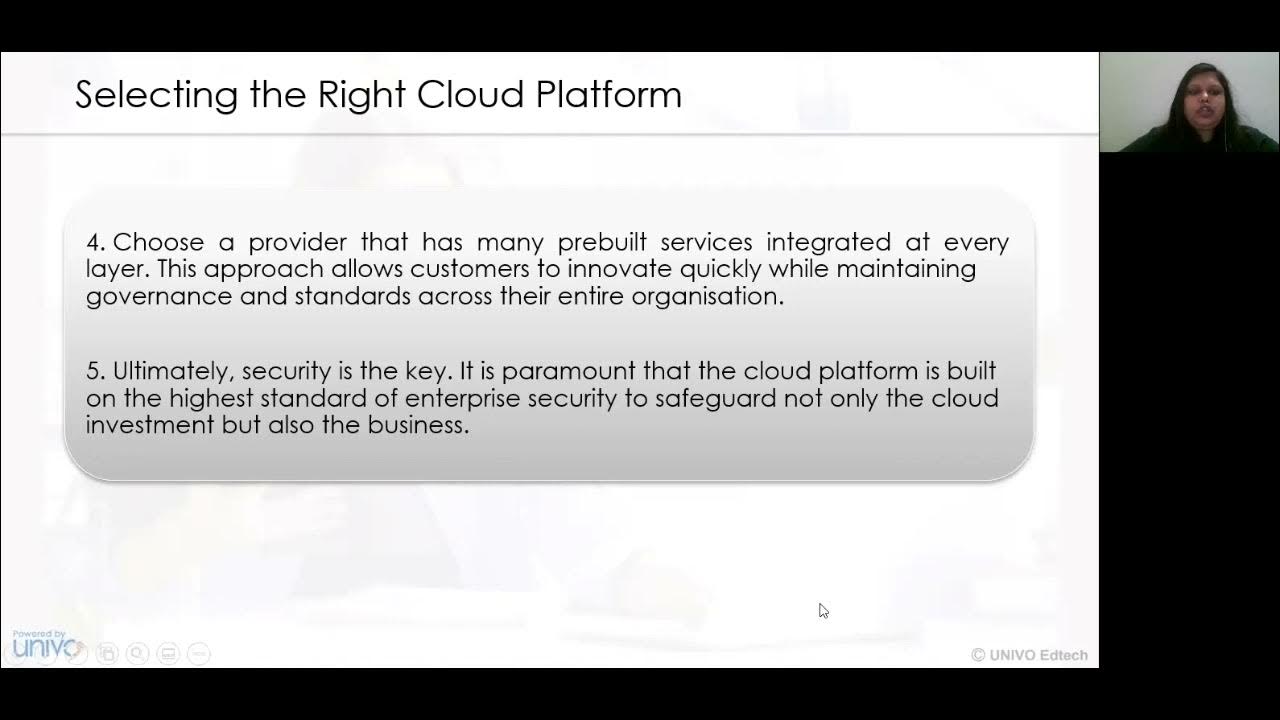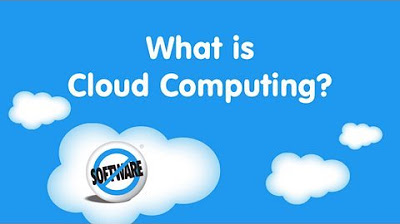Cloud Economics Cloud Computing infrastructures available for implementing cloud based services
Summary
TLDRThis session explores cloud economics, focusing on the costs, benefits, and principles driving cloud computing. It discusses key concepts like Return on Investment (ROI) and Total Cost of Ownership (TCO), highlighting cloud's economic advantages, such as economies of scale, global reach, and business agility. The components of cloud infrastructure—management software, hypervisor, network, server, and storage—are detailed, along with their roles. The session also outlines challenges like transparency, scalability, monitoring, and security in cloud systems. Overall, it provides a comprehensive look at the economic and infrastructural aspects of cloud computing.
Takeaways
- 💡 Cloud economics studies the costs, benefits, and economic principles of cloud computing.
- 📊 Key metrics for cloud economics include Return on Investment (ROI) and Total Cost of Ownership (TCO).
- 💸 Cloud providers save organizations money through economies of scale and a pay-as-you-go pricing model.
- 🌍 Global reach of cloud computing allows businesses to reduce costs by eliminating the need for on-premises servers.
- ⚙️ Cloud infrastructure consists of six key components: management software, deployment software, hypervisor, network, server, and storage.
- 🔗 The hypervisor manages shared cloud resources across multiple tenants.
- 🌐 Network components allow cloud services to be accessed globally, enabling businesses to operate remotely.
- 📦 Cloud storage provides redundancy through multiple replicas of data, ensuring reliability and availability.
- 📈 Cloud enables business agility by allowing faster deployment and scaling of resources on-demand, leading to faster growth.
- 🚧 Infrastructural constraints of the cloud include the need for transparency, scalability challenges, intelligent monitoring, and security concerns.
Q & A
What is cloud economics?
-Cloud economics is the study of cloud computing costs and benefits, as well as the economic principles that underpin them. It involves understanding the return on investment (ROI) and total cost of ownership (TCO) when migrating to the cloud or switching cloud providers.
What are the two primary economic benefits of cloud computing?
-The two primary economic benefits of cloud computing are economies of scale and global reach. Economies of scale allow cloud providers to purchase computing resources in massive quantities at lower costs, which they then share with organizations, saving them from substantial upfront capital expenditure. Global reach enables organizations to access services from anywhere in the world, reducing the need for physical servers and associated costs.
How does the pay-as-you-go pricing model benefit companies using cloud services?
-The pay-as-you-go pricing model allows companies to pay only for the resources they actively use, scaling up or down as needed. This means organizations avoid large upfront costs and can adjust their spending based on their current usage, making it a flexible and cost-effective option.
What is the role of a hypervisor in cloud infrastructure?
-A hypervisor is a firmware or low-level program that acts as a virtual machine manager. It allows the sharing of a single physical instance of cloud resources between several tenants, managing and facilitating the proper distribution of these resources to various users accessing them.
What are the six components of cloud infrastructure mentioned in the script?
-The six components of cloud infrastructure are management software, deployment software, hypervisor, network, server, and storage. These components work together to manage and deliver cloud services effectively.
How does cloud computing enhance business agility?
-Cloud computing enhances business agility by allowing companies to deploy applications faster and ramp up storage and computing power on demand. This agility enables businesses to respond more quickly to market changes and customer demands, potentially leading to faster revenue growth.
What are some of the infrastructural constraints of cloud computing?
-Some infrastructural constraints of cloud computing include the need for transparency in resource sharing, the challenge of scaling applications and solutions, the requirement for intelligent monitoring, and ensuring security in the mega data centers and control nodes.
Why is transparency important in cloud infrastructure?
-Transparency is important in cloud infrastructure because it allows for the proper management and scaling of resources on demand. Without transparency, it would be difficult to balance load, allocate resources effectively, and ensure that the cloud environment meets the needs of all users.
How does the global reach of cloud computing impact organizations?
-The global reach of cloud computing allows organizations to access services from anywhere in the world without the need for physical servers on premises. This can reduce labor costs, eliminate the need for maintaining complex hardware on-site, and save on location costs, as employees can access data from remote locations.
What is the significance of storage in cloud infrastructure?
-Storage in cloud infrastructure is significant because it holds multiple replicas of files, ensuring data reliability and redundancy. If one storage resource fails, data can be retrieved from another replica, preventing data loss and ensuring continuous access to information.
What are the key questions cloud economics explores for businesses?
-Cloud economics explores key questions for businesses such as the return on investment (ROI) of migrating to the cloud or switching cloud providers, and comparing the total cost of ownership (TCO) of a cloud solution versus a traditional on-premises solution.
Outlines

このセクションは有料ユーザー限定です。 アクセスするには、アップグレードをお願いします。
今すぐアップグレードMindmap

このセクションは有料ユーザー限定です。 アクセスするには、アップグレードをお願いします。
今すぐアップグレードKeywords

このセクションは有料ユーザー限定です。 アクセスするには、アップグレードをお願いします。
今すぐアップグレードHighlights

このセクションは有料ユーザー限定です。 アクセスするには、アップグレードをお願いします。
今すぐアップグレードTranscripts

このセクションは有料ユーザー限定です。 アクセスするには、アップグレードをお願いします。
今すぐアップグレード関連動画をさらに表示

Economics of choosing a Cloud platform for an organization based on application requirements, eco

Cloud Computing Vs Fog Computing | How Does Fog Computing Works | Cloud Vs Fog | Intellipaat

Módulo 9 - Cloud Trends

AWS Cloud Economics | AWS Tutorial For Beginners | Simplilearn

What is Cloud Computing?

Cloud Computing Costs and ROI
5.0 / 5 (0 votes)
